-meit
On this page, you find all documents, package deals, and flashcards offered by seller -meit.
- 18
- 1
- 1
Community
- Followers
- Following
19 items

BIOL&211 - (Chapter 9) Respiration [Page 1]
Respiration basics - Discuss the significance of respiration process in the cell - List the major stages of respiration process Glycolysis - Describe the major molecules involved in process of glycolysis as well as location of glycolysis in the cell - Discuss the significance of pyruvate in the cell The citric acid cycle (also known as the Krebs cycle) - List major molecules involved in Citric Acid Cycle as well as location of the cycle in the cell Oxidative Phosphorylation - Distinguis...
- Package deal
- Class notes
- • 1 pages •
Respiration basics - Discuss the significance of respiration process in the cell - List the major stages of respiration process Glycolysis - Describe the major molecules involved in process of glycolysis as well as location of glycolysis in the cell - Discuss the significance of pyruvate in the cell The citric acid cycle (also known as the Krebs cycle) - List major molecules involved in Citric Acid Cycle as well as location of the cycle in the cell Oxidative Phosphorylation - Distinguis...

BIOL&211 - (Chapter 6) Cell Tour [Page 2]
Cell basics -Compare prokaryotic and eukaryotic cell as well as animal and plant cells and describe their basic structural components -Describe the structure of nucleus, its function and components -Explain the function of free and bound ribosomes Endomembrane system -Describe the endomembrane system of the cell, its structural components members and its function -Compare smooth and rough endoplasmic reticulum, their structure and function -Discuss structure and function of Golgi apparatu...
- Package deal
- Class notes
- • 1 pages •
Cell basics -Compare prokaryotic and eukaryotic cell as well as animal and plant cells and describe their basic structural components -Describe the structure of nucleus, its function and components -Explain the function of free and bound ribosomes Endomembrane system -Describe the endomembrane system of the cell, its structural components members and its function -Compare smooth and rough endoplasmic reticulum, their structure and function -Discuss structure and function of Golgi apparatu...
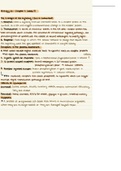
BIOL&211 - (Chapter 11) Cell Communication [Page 2]
Cell Signaling -Discuss the differences between local signaling and long-distance cellular communication -Describe the three stages of cell signaling. Receptor Proteins -Know what receptor proteins are, where they are located, and what they do -Know the three cell surface receptor superfamilies, the basic structures of each and how each functions to convert an extracellular signal to an internal one. -Differentiate between intracellular receptors and cell surface receptors in terms of func...
- Package deal
- Class notes
- • 1 pages •
Cell Signaling -Discuss the differences between local signaling and long-distance cellular communication -Describe the three stages of cell signaling. Receptor Proteins -Know what receptor proteins are, where they are located, and what they do -Know the three cell surface receptor superfamilies, the basic structures of each and how each functions to convert an extracellular signal to an internal one. -Differentiate between intracellular receptors and cell surface receptors in terms of func...
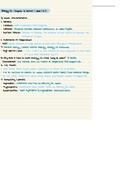
BIOL&211 - (Chapter 3) Themes of Biology, Water and Life [Page 2]
Water -Describe the physical and chemical properties of a water -Explain how hydrogen bonds result in cohesive and adhesive properties of water -Explain how water resists temperature changes -Describe evaporative cooling -Explain why water is called universal solvent
- Package deal
- Class notes
- • 1 pages •
Water -Describe the physical and chemical properties of a water -Explain how hydrogen bonds result in cohesive and adhesive properties of water -Explain how water resists temperature changes -Describe evaporative cooling -Explain why water is called universal solvent
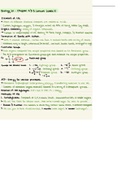
BIOL&211 - (Ch4&5) Structure and Function of Large Biological Molecules [Page 1]
O-Chem basics -Describe C atom, its bonds and importance of hydrocarbons -Distinguish between seven major functional groups -Know the basic structure of ATP and ADP 4 major macromolecules -Explain basic structure and functions of simple and complex sugars -Discuss different types of lipids and their role in biology -Describe protein chemical structure -Differentiate and discuss many different functions of proteins -Briefly explain the basic structure of nucleic acids and the difference ...
- Package deal
- Class notes
- • 1 pages •
O-Chem basics -Describe C atom, its bonds and importance of hydrocarbons -Distinguish between seven major functional groups -Know the basic structure of ATP and ADP 4 major macromolecules -Explain basic structure and functions of simple and complex sugars -Discuss different types of lipids and their role in biology -Describe protein chemical structure -Differentiate and discuss many different functions of proteins -Briefly explain the basic structure of nucleic acids and the difference ...
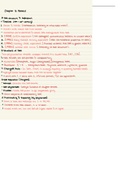
BIOL&211 - (Chapter 16) DNA Structure & Replication [Page 1]
Structure of DNA -Identify key events leading to the discovery of the structure of DNA -Describe Watson and Crick’s three-dimensional model of DNA -Identify the three subunits of DNA and describe how they are put together to construct an intact molecule -Understand the importance of Chargaff’s rules and the complementary nature of nucleotide bases DNA replication -Know what is meant by semiconservative replication of DNA and how it was determined -Know the major enzymes involved in DN...
- Package deal
- Class notes
- • 1 pages •
Structure of DNA -Identify key events leading to the discovery of the structure of DNA -Describe Watson and Crick’s three-dimensional model of DNA -Identify the three subunits of DNA and describe how they are put together to construct an intact molecule -Understand the importance of Chargaff’s rules and the complementary nature of nucleotide bases DNA replication -Know what is meant by semiconservative replication of DNA and how it was determined -Know the major enzymes involved in DN...
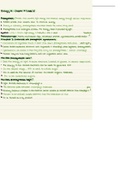
BIOL&211 - (Chapter 10) Photosynthesis [Page 1]
Basics -Write an equation of photosynthesis -Describe the basic structure of a chloroplast and similarities with photosynthetic cyanobacteria -Distinguish between light and dark phase of photosynthesis Light reactions -Discuss oxygen production and generation of ATP and NADH during light phase of photosynthesis -Locate Photosystem II (PSII) and Photosystem I (PSI) in the light phase -Compare process of chemiosmosis in mitochondria and chloroplast -Describe Electron Transport Chain and it...
- Package deal
- Class notes
- • 1 pages •
Basics -Write an equation of photosynthesis -Describe the basic structure of a chloroplast and similarities with photosynthetic cyanobacteria -Distinguish between light and dark phase of photosynthesis Light reactions -Discuss oxygen production and generation of ATP and NADH during light phase of photosynthesis -Locate Photosystem II (PSII) and Photosystem I (PSI) in the light phase -Compare process of chemiosmosis in mitochondria and chloroplast -Describe Electron Transport Chain and it...
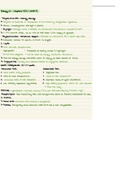
BIOL&211 - (Ch4&5) Structure and Function of Large Biological Molecules [Page 2]
O-Chem basics -Describe C atom, its bonds and importance of hydrocarbons -Distinguish between seven major functional groups -Know the basic structure of ATP and ADP 4 major macromolecules -Explain basic structure and functions of simple and complex sugars -Discuss different types of lipids and their role in biology -Describe protein chemical structure -Differentiate and discuss many different functions of proteins -Briefly explain the basic structure of nucleic acids and the difference ...
- Package deal
- Class notes
- • 1 pages •
O-Chem basics -Describe C atom, its bonds and importance of hydrocarbons -Distinguish between seven major functional groups -Know the basic structure of ATP and ADP 4 major macromolecules -Explain basic structure and functions of simple and complex sugars -Discuss different types of lipids and their role in biology -Describe protein chemical structure -Differentiate and discuss many different functions of proteins -Briefly explain the basic structure of nucleic acids and the difference ...
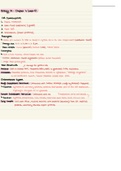
BIOL&211 - (Chapter 6) Cell Tour [Page 1]
Cell basics -Compare prokaryotic and eukaryotic cell as well as animal and plant cells and describe their basic structural components -Describe the structure of nucleus, its function and components -Explain the function of free and bound ribosomes Endomembrane system -Describe the endomembrane system of the cell, its structural components members and its function -Compare smooth and rough endoplasmic reticulum, their structure and function -Discuss structure and function of Golgi apparatu...
- Package deal
- Class notes
- • 1 pages •
Cell basics -Compare prokaryotic and eukaryotic cell as well as animal and plant cells and describe their basic structural components -Describe the structure of nucleus, its function and components -Explain the function of free and bound ribosomes Endomembrane system -Describe the endomembrane system of the cell, its structural components members and its function -Compare smooth and rough endoplasmic reticulum, their structure and function -Discuss structure and function of Golgi apparatu...
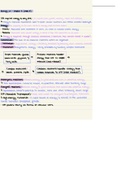
BIOL&211 - (Chapter 8) Metabolism [Page 1]
Cellular energetics -Discuss the major types of energy -Define metabolism, catabolism and anabolism -Distinguish between exergonic and endergonic reactions -Describe the structure and importance of ATP for the cell Enzymes -Describe the role of enzymes in cellular biochemical reactions -Discuss the mechanism of enzyme action and the importance of an active site -Describe different types of enzyme inhibition -Explain allosteric regulation of enzymes -Connect the concept of negative feed...
- Package deal
- Class notes
- • 1 pages •
Cellular energetics -Discuss the major types of energy -Define metabolism, catabolism and anabolism -Distinguish between exergonic and endergonic reactions -Describe the structure and importance of ATP for the cell Enzymes -Describe the role of enzymes in cellular biochemical reactions -Discuss the mechanism of enzyme action and the importance of an active site -Describe different types of enzyme inhibition -Explain allosteric regulation of enzymes -Connect the concept of negative feed...
